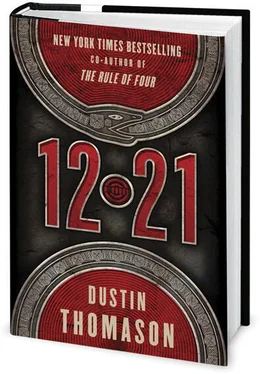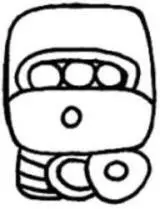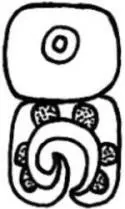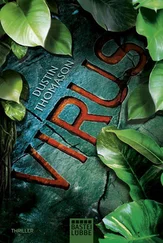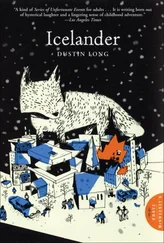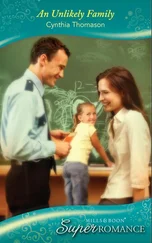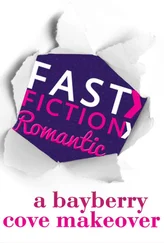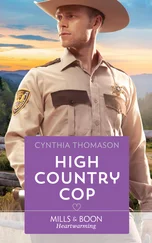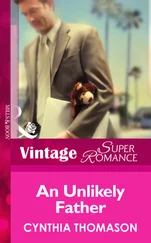There was a quiet knock on her office door, followed by Rolando Chacon popping his head inside. “Got a minute?”
She waved him in. He’d listened without judgment as she told him about the hospital, including how she’d lied to the doctors about Volcy’s reasons for coming to the States.
“You okay?” Rolando asked, taking the seat in front of her.
She shrugged.
“Maybe you should go home and get some sleep.”
“I’m fine,” she said. “What is it?”
“The C-14 dating came back: 930 plus or minus 150. Exactly what we thought. Middle of the terminal classic.”
Chel should have been ecstatic. This was the proof they’d been waiting for. Everything she’d learned and understood about her work had come together, and the codex could be a portal to immense understanding. Still, she felt nothing.
“Great,” she told Ronaldo without emotion.
“I’m also moving forward with the reconstruction,” he said. “But there’s a problem.” He passed Chel a piece of paper, on which he’d drawn two symbols:
In ancient Mayan, they were pronounced chit and unen . “A father, and a male child of the father,” Chel said absently. “A father and his son.”
“But that’s not how the scribe is using it.” Rolando handed her another page. “That’s a rough translation of the second paragraph.”
The father and his son is not noble by birth, and so there is much the father and his son will never fathom about the ways of the gods that watch over us, there is much the father and his son does not hear that the gods would whisper in the ears of a king.
“So it has to be one thing he’s referring to,” Rolando said. “One noble. One king. Something like that. Whatever it is, the pair of symbols appears all over the manuscript.”
Chel studied the glyphs again. Scribes commonly used word pairings in new ways for stylistic flourish, so it was likely this one was using the pair to signify something other than the literal translation.
“Could it have something to do with noble titles being passed down from fathers to their sons?” Rolando asked. “Patrilinearity?”
Chel doubted it but was having trouble focusing. “Let me think about it.”
Rolando tapped on her desk. “I know you don’t want to hear this, and I understand your concerns, really. But this is really a syntax question, and Victor’s the best there is. He could be very helpful with this, and I think you have to put your personal issues aside.”
“You and I can figure it out,” Chel said.
“Until we know what this is, it’ll be diffi cult to make much more progress. On the first page alone the combination appears ten times after the first paragraph. On some of the later pages it shows up two dozen times.”
“ I’ll work on it,” Chel told him. “Thanks,” she added.
Rolando retreated into the lab, and Chel went back to her laptop.
Checking the Los Angeles Times site, she found newly posted articles about Volcy and Presbyterian. But something else caught her attention: photographs of cars piled up atop one another on the 101 freeway, and people being pulled from the wreckage. In the middle of it all was a green SUV.
* * *
STANTON STOOD WITH Davies in the morgue, deep in the basement of the hospital. The driver’s body lay on one metal table; beside them, on a second table, lay Volcy’s.
Davies made an incision from ear to ear on the driver’s skull, then draped the flap of skin and removed the skullcap to expose the brain.
“Ready,” he said.
Stanton stepped forward, cut the central cortex away from the cranial nerves, and disconnected it from the spinal cord. Reaching inside, he removed the brain from its skull. Hidden in the folds of this organ was his best hope for figuring out VFI. He placed the brain on a sterile table, trying to ignore the fact that it was still warm.
Stanton and Davies began to slice. During his gross exam of the thalamus, Stanton saw clusters of tiny holes; under the microscope he saw a wasteland of craters and deformed tissue. Textbook FFI. Only much, much more aggressive.
“Anything?” Davies asked.
“Give me a second.” Stanton rubbed his eyes.
“You look knackered,” Davies said.
“I have no idea what that means.”
“You look like shit. You need to sleep, Gabe.”
“We all do.”
Davies snickered. “I’ll sleep when I’m like these blokes.”
“Come on.”
“Too soon?”
Once they finished with the driver’s brain, they performed the same operation on Volcy’s distended body. When they had sections from both brains ready, Stanton put his eye to the microscope again, upping the background light. The craters in Volcy’s brain ran deeper and the cortex looked more deformed. He had definitely been infected first.
Stanton had suspected as much, but until now he hadn’t realized what he could do with the information. “Make images of all these sections,” he told Davies. “And I want you to find the MRIs we took of Volcy when he was still alive. Figure out how fast the disease was spreading in his brain, then model everything backward. If we can figure out the rate of progression, then we can estimate when they both got sick.”
Davies nodded. “A timeline.”
If they could determine when Volcy took ill, they might be able to figure out where he’d gotten sick. With luck, they could do the same for the driver. The driver was the key: Someone in this city knew him. Once the driver was identifi ed, there’d be bank statements and credit-card receipts showing where he bought his groceries, where he ate. A paper trail leading straight to the source.
“Cavanagh’s on the line,” Davies said, holding out his cellphone.
Stanton peeled off his second layer of gloves. Into the phone he said one word: “Confirmed.”
Cavanagh took a deep breath. “You’re sure?”
“Same disease, different stages.”
“I’m getting on a plane right now. Tell me what you need to keep this under control.”
“An ID on the driver. We have two patients, and they were both John Does when they came in.” The Explorer was unregistered, and its driver, like Volcy, carried nothing to identify him. The worry was that this somehow wasn’t a coincidence. But what would that mean?
“The police are working on it,” Cavanagh said. “What else?”
“The public needs to know we found a second case. And they need to know it from us. Not from some blogger who makes half of it up.”
“If you’re asking for a press conference, the answer is no. Not yet. Everyone in the city will think they’re sick.”
“Then at least get the grocery stores to put a hold on dairy, and meat too, just to be safe. Get USDA to investigate all possible imports from Guatemala. And tell people they need to throw away the milk and all the rest in their refrigerators.”
“Not until we confirm the source of the disease.”
“If you want confirmation, get all of our agents here checking the pupil size of every patient in every hospital,” he said. “And I’m not just talking about L.A. I’m talking about the valley, Long Beach, Anaheim. I need more than two data points.”
“I’m supervising agents on the ground there already. Let them do their jobs.”
Stanton pictured Cavanagh’s unflappable stare. She’d become the brightest star at CDC in 2007, when an airplane passenger was suspected of carrying drug-resistant TB. She was one of the few at the center to remain levelheaded until the scare passed and had been a favorite in Washington ever since. But now wasn’t the time to be levelheaded.
Читать дальше
